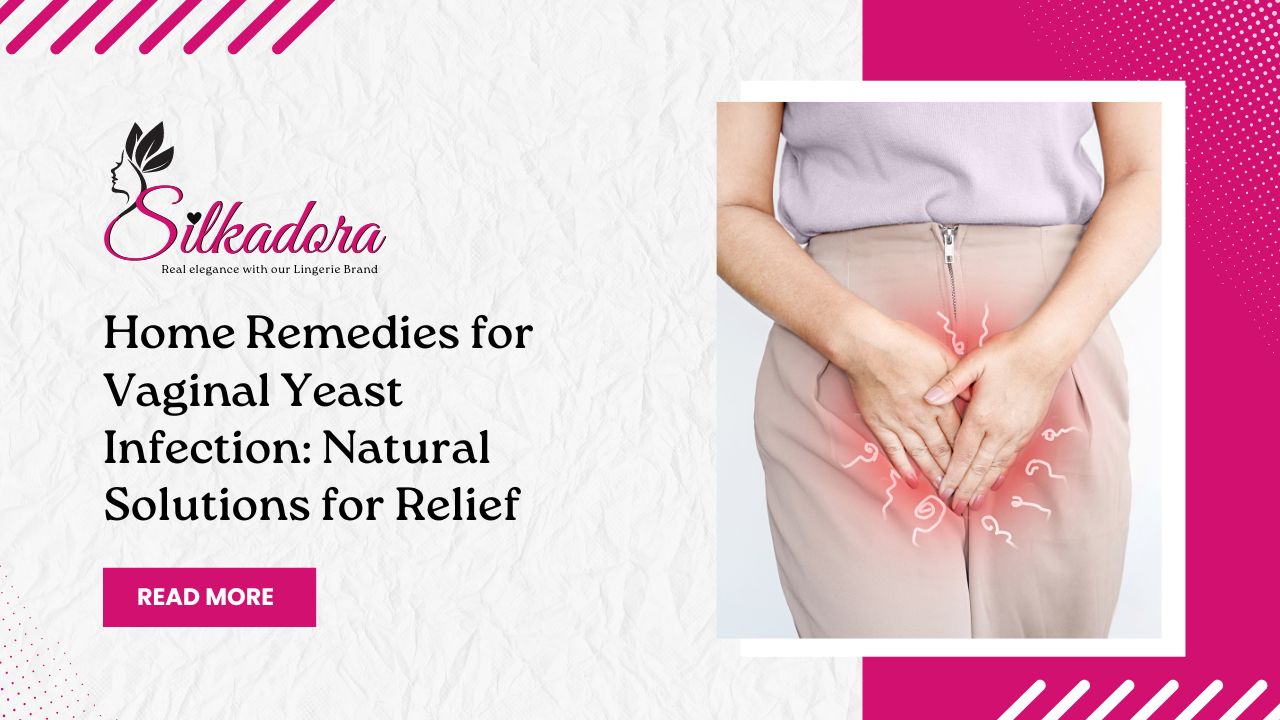Dealing with the discomfort and irritation of a vaginal yeast infection is no fun. But fear not, natural relief may be closer than you think! In this blog post, we’ll explore some effective home remedies that can help alleviate symptoms and promote healing. From tea tree oil to yogurt, discover how these simple yet powerful solutions can bring much-needed comfort and balance back to your intimate health. Say goodbye to pesky yeast infections with these natural remedies – your body will thank you!
What is a Vaginal Yeast Infection?
A vaginal yeast infection, also known as candidiasis, is a common fungal infection that affects many women at some point in their lives. It occurs when there is an overgrowth of the Candida fungus in the vagina, leading to symptoms like itching, burning, and abnormal discharge.
Yeast infections can be triggered by various factors such as hormonal changes, antibiotic use, a weakened immune system, or even wearing tight clothing. The warm and moist environment of the vagina provides an ideal breeding ground for yeast to thrive and multiply rapidly.
When left untreated, yeast infections can cause discomfort and disrupt daily activities. It’s important to recognize the signs early on and seek appropriate treatment to prevent complications. By understanding what a vaginal yeast infection entails, you can take proactive steps towards managing your intimate health effectively.
Causes and Risk Factors
Vaginal yeast infections are commonly caused by an overgrowth of the fungus Candida albicans, which is naturally present in the vagina. Various factors can disrupt the delicate balance that keeps this fungus in check, leading to an infection.
One common cause is the use of antibiotics, which can kill off good bacteria along with harmful ones, allowing yeast to proliferate. Hormonal changes due to pregnancy or taking birth control pills can also increase the risk of developing a yeast infection.
Poorly controlled diabetes and a weakened immune system can make individuals more susceptible to these infections as well. Tight clothing made from non-breathable materials like nylon can create a warm and moist environment ideal for fungal growth.
High-sugar diets and stress may also contribute to imbalances in vaginal flora. Understanding these causes and risk factors can help you take preventive measures and seek appropriate treatment if needed.
Symptoms of a Vaginal Yeast Infection
Vaginal yeast infections can cause a range of uncomfortable symptoms that can disrupt daily life. Symptoms may include intense itching and irritation in the vaginal area, along with burning sensations during urination or sex. Some individuals also experience redness and swelling of the vulva, as well as thick, white vaginal discharge that resembles cottage cheese.
It’s important to note that not everyone experiences the same symptoms or severity when dealing with a yeast infection. For some, the discomfort may be mild and easily managed with home remedies, while for others it can be more persistent and bothersome. Additionally, recurring yeast infections could indicate an underlying issue that needs to be addressed by a healthcare provider.
Being aware of these common symptoms is key to identifying a potential yeast infection early on so that appropriate measures can be taken to find relief and prevent further complications.
Home Remedies for Vaginal Yeast Infection:
Vaginal yeast infections can be uncomfortable and frustrating. Luckily, there are natural remedies you can try to find relief at home. These remedies often use simple ingredients that may already be in your kitchen or bathroom.
Tea tree oil is known for its antifungal properties and can be diluted with a carrier oil before being applied topically to the affected area. Garlic is another option, as it contains allicin, which has shown antifungal effects.
Probiotics are beneficial bacteria that can help restore the balance of good bacteria in your body, potentially reducing yeast overgrowth. Apple cider vinegar has been used for various health purposes, including treating yeast infections when diluted and used as a wash.
Yogurt containing live cultures may also help rebalance vaginal flora when applied topically or consumed orally. Additionally, taking a baking soda bath or using coconut oil may provide soothing relief from symptoms like itching and irritation.
A. Tea Tree Oil
Tea tree oil is a popular natural remedy known for its antifungal properties, making it a promising solution for vaginal yeast infections. This essential oil is derived from the leaves of the Melaleuca alternifolia plant, native to Australia.
When using tea tree oil for a vaginal yeast infection, it’s important to dilute it properly before applying. Mixing a few drops of tea tree oil with a carrier oil like coconut or olive oil can help prevent skin irritation.
The anti-inflammatory and antimicrobial properties in tea tree oil can help combat the overgrowth of yeast in the vagina. By applying diluted tea tree oil topically to the affected area, you may experience relief from itching and discomfort.
Remember that while tea tree oil can be effective for some individuals, it’s essential to do a patch test first to ensure you don’t have any adverse reactions. Always consult with your healthcare provider before trying any new home remedy.
B. Garlic
Garlic, a staple in many kitchen cabinets, holds potential beyond just adding flavor to your dishes. This pungent bulb is believed to have natural antifungal properties that can help combat vaginal yeast infections.
To use garlic for relief, you can create a homemade suppository by wrapping a peeled clove in gauze and inserting it into the vagina overnight. The allicin compound in garlic is thought to be responsible for its antifungal effects.
However, it’s essential to proceed with caution when using garlic as a home remedy. Some women may experience irritation or burning sensations from direct contact with raw garlic.
While some swear by this method as an effective natural solution for yeast infections, others may find it uncomfortable or ineffective. As with any home remedy, it’s advisable to consult with a healthcare provider before trying alternative treatments like garlic for vaginal yeast infections.
C. Probiotics
Probiotics are beneficial bacteria that can help restore the natural balance in your body, including your vaginal flora. By taking probiotics orally or using them topically, you can support a healthy environment in your vagina and potentially reduce the overgrowth of yeast.
These good bacteria work by competing with harmful organisms like yeast for space and resources, helping to prevent their proliferation. Look for probiotic supplements specifically formulated for vaginal health containing strains such as Lactobacillus rhamnosus or Lactobacillus reuteri.
In addition to oral supplements, you can also consider using probiotic-rich foods like yogurt or kefir. Eating these regularly may help promote a healthy gut microbiome, which is linked to overall well-being and immune function.
Remember that while probiotics can be a helpful addition to your routine, they should not replace medical treatment if you suspect a severe yeast infection. Always consult with a healthcare provider for proper diagnosis and guidance on treatment options.
D. Apple Cider Vinegar
Apple cider vinegar is a popular natural remedy for various health issues, including vaginal yeast infections. Its acidic properties help restore the natural pH balance of the vagina, creating an environment less conducive to yeast growth.
To use apple cider vinegar for relief, dilute it with water and apply it externally to the affected area using a cotton ball. Remember to never apply undiluted apple cider vinegar directly on your skin as it can cause irritation.
You can also add a cup of apple cider vinegar to your bathwater and soak in it for about 20 minutes. This method may help alleviate itching and discomfort associated with yeast infections.
Some women find that consuming diluted apple cider vinegar orally helps improve their symptoms by targeting the infection from within. However, always consult with a healthcare provider before trying this method to ensure it is safe for you.
While apple cider vinegar may offer some relief for vaginal yeast infections, results can vary from person to person. If you experience severe or persistent symptoms, it’s important to seek medical advice for proper diagnosis and treatment options.
E. Yogurt
Yogurt is not just a tasty treat; it can also be a helpful home remedy for vaginal yeast infections. The live cultures in yogurt, specifically Lactobacillus acidophilus, can help restore the natural balance of good bacteria in the vagina.
When choosing yogurt to use as a remedy, opt for plain, unsweetened yogurt with live and active cultures. You can apply the yogurt directly to the affected area or even consume it regularly to promote healthy bacteria growth internally.
For external application, simply spread a thin layer of yogurt on a clean tampon and insert it into the vagina for about two hours. Remember to wash thoroughly after this treatment.
Incorporating plain yogurt into your diet can also be beneficial in maintaining vaginal health and preventing future yeast infections. So next time you’re at the grocery store, consider adding some plain yogurt to your shopping list!
Other Natural Solutions for Relief:
Looking for more natural ways to find relief from a vaginal yeast infection? Here are some other remedies you can try out:
First up, a baking soda bath. Adding baking soda to your bathwater can help alleviate itching and irritation in the vaginal area. It helps restore the pH balance and reduce the overgrowth of yeast.
Another option is coconut oil. Known for its antifungal properties, coconut oil can be applied topically to soothe discomfort and fight off yeast infections. Make sure to use organic, virgin coconut oil for maximum benefits.
These additional natural solutions provide alternative methods to ease symptoms and promote healing without harsh chemicals or medications. Experiment with these options to discover what works best for you and your body’s needs when dealing with a vaginal yeast infection.
A. Baking Soda Bath
Looking for a soothing and natural way to alleviate the discomfort of a vaginal yeast infection? Consider trying a baking soda bath. Baking soda, also known as sodium bicarbonate, can help balance pH levels in the body and relieve itching and irritation.
To prepare a baking soda bath, simply add about half a cup of baking soda to your warm bath water. Make sure the baking soda dissolves completely before soaking in it. The gentle properties of baking soda can help neutralize acidic vaginal secretions that contribute to yeast overgrowth.
Taking regular baking soda baths may provide temporary relief from symptoms like itching and burning associated with vaginal yeast infections. However, it’s essential to consult with your healthcare provider before trying any new home remedy.
Remember that while home remedies like baking soda baths can offer temporary relief, they should not replace medical treatment prescribed by your healthcare provider.
B. Coconut Oil
Coconut oil, a versatile remedy known for its many health benefits, can also be used to help relieve symptoms of a vaginal yeast infection. Its natural anti-fungal properties make it an effective treatment option.
To use coconut oil for relief, ensure you are using virgin or unrefined coconut oil. You can apply a small amount directly to the affected area or create a mixture with tea tree oil for added antifungal power.
Coconut oil can help soothe itching and irritation while combating the overgrowth of yeast in the vagina. It’s important to note that while coconut oil may offer temporary relief from symptoms, it is not a cure for yeast infections.
Remember to consult with your healthcare provider if you have persistent or severe symptoms of a vaginal yeast infection. Coconut oil is just one of many natural remedies that may provide some relief when dealing with this common issue.
Conclusion
Incorporating these natural remedies into your daily routine can help ease the discomfort and symptoms associated with a vaginal yeast infection. From tea tree oil to probiotics and yogurt, there are plenty of options to choose from when seeking relief.
Remember, it’s essential to consult with your healthcare provider if you suspect you have a vaginal yeast infection, especially if you’re pregnant or experiencing recurring infections. Prioritize your health and well-being by taking proactive steps towards treating and preventing future occurrences.
By being mindful of your body’s needs and utilizing these home remedies, you can find comfort and relief in managing vaginal yeast infections naturally. Embrace the power of nature in restoring balance to your body, promoting overall wellness from within.
Frequently Asked Questions (FAQs)
In some cases, mild yeast infections may resolve on their own. However, it’s essential to consult with a healthcare provider for proper diagnosis and treatment.
Natural remedies can offer relief for some individuals, but it’s crucial to be cautious and seek medical advice if symptoms persist or worsen.
The effectiveness of home remedies varies from person to person. It’s recommended to give them time and consistency before expecting significant results.
While generally considered safe, some people may experience skin irritation or allergic reactions. Always do a patch test before applying any new remedy.
If you experience recurrent infections, severe discomfort, or unusual discharge, it’s best to seek professional medical guidance promptly.










